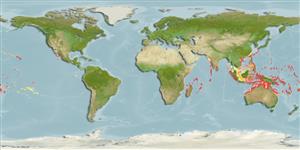Common names from other countries
Environment: milieu / climate zone / depth range / distribution range
Écologie
marin récifal; profondeur 0 - 50 m (Ref. 90102). Tropical; 30°N - 25°S
Indo-Pacific: Maldives to the Tuamoto Islands, north to Ryukyu Islands, south to the Great Barrier Reef.
Taille / Poids / Âge
Maturity: Lm ? range ? - ? cm
Max length : 26.0 cm TL mâle / non sexé; (Ref. 9710)
Épines dorsales (Total) : 13 - 14; Rayons mous dorsaux (Total) : 23 - 26; Épines anales: 3; Rayons mous anaux: 19 - 22. The abdominal region of females is noticeably thick set. Body is golden yellow; base of the posterior portions of the dorsal and anal fins black; a prominent vertical black bar running across the eye; diagonal rows of black dots on the sides. A filament originating from the soft portions of the dorsal fin rays trails posteriorly (Ref. 4855). Snout length 2.4-2.9 in HL. Body depth 1.6-1.9 in SL (Ref. 90102).
Uncommon species (Ref. 9710) found in coral rich areas of clear water lagoon and semi-protected seaward reefs. Usually in pairs or small groups, more wary than most species. Minimum depth reported taken from Ref. 30874. Oviparous (Ref. 205). Minimum depth reported taken from Ref. 128797.
Life cycle and mating behavior
Maturities | Reproduction | Spawnings | Egg(s) | Fecundities | Larves
Distinct pairing (Ref. 205).
Myers, R.F., 1991. Micronesian reef fishes. Second Ed. Coral Graphics, Barrigada, Guam. 298 p. (Ref. 1602)
Statut dans la liste rouge de l'IUCN (Ref. 130435)
CITES (Ref. 128078)
Not Evaluated
Menace pour l'homme
Harmless
Utilisations par l'homme
Pêcheries: intérêt commercial mineur; Aquarium: Commercial
Outils
Articles particuliers
Télécharger en XML
Sources Internet
Estimates based on models
Preferred temperature (Ref.
115969): 24.9 - 28.9, mean 27.7 (based on 646 cells).
Phylogenetic diversity index (Ref.
82804): PD
50 = 0.5000 [Uniqueness, from 0.5 = low to 2.0 = high].
Bayesian length-weight: a=0.02291 (0.01133 - 0.04632), b=3.00 (2.83 - 3.17), in cm Total Length, based on LWR estimates for this Genus-body shape (Ref.
93245).
Niveau trophique (Ref.
69278): 2.7 ±0.25 se; based on food items.
Résilience (Ref.
120179): Haut, temps minimum de doublement de population inférieur à 15 mois (Preliminary K or Fecundity.).
Fishing Vulnerability (Ref.
59153): Low vulnerability (16 of 100).
